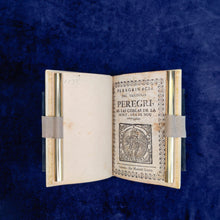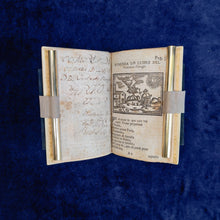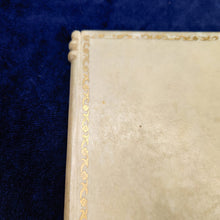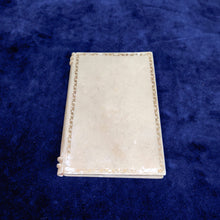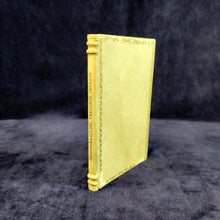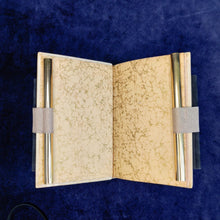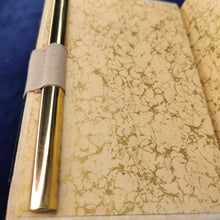
Peregrinacio del Venturós Pelegrí ab las Coblas de la Mort, ara de nou corregidas. Cervera : Per Manuel Ibarra [n.d., 1739-1747]
(90 x 140 mm) [6] 48 [6]. Original cover page with printer’s device and ornamental border, blank on verso with reader/ownership mark in contemporary pen. Seven wood block illustrations (pp. 3, 5, 6, 8, 9 20, 33) embellishing the text in Catalan. Ornamental end pieces consisting of asterisks. Fine binding with some trauma to lower gold-embossed border. Title in gold on spine with four ornamental bands. Pink and gold pastedown and fly leaves and additional blank fly leaves inserted. Overall GOOD condition.
About the Catalan poem:
Catalan is a Romance family language, spoken in Andorra, parts of France, the Baleric Islands in the Mediterranean, and Catalonia, the autonomous community in Spain . UNESCO classifies it today as a vulnerable language, as it suffered suppression by various Spanish and French governments. Today, however, it is an official, recognised, and well-promoted language. The poem preserved in this small book appears in Catalan during a time when the language was persecuted.
“The Pilgrimage of the Adventurous Pilgrim” and the “Stanzas of Death” (as the titles translate to in English from Catalan) find their origin in medieval literature, with their popularity extending past manuscript into printed books of the 18th and 19th centuries. The story is simple: a pilgrim sets off on his way to Rome, travels through inhospitable lands and is rocked by a supernaturally strong storm (which appears to include a fire breathing hell-mouth). The pilgrim cry out for the aid of the Virgin and is met by a didactic soul, who is joined by Death, an Angel, and the Devil.
About the Printer, the Spanish War of Succession, and the Printing:
Emanuel Ibarra was a printer who was born in 1709 and died in 1757; he worked in Cervera, a town about 100k to the northwest of Barcelona. The larger machinations of national-building Europe were at work in this century, and Cervera ended up a university town in need of a printer for about a century.
Though Charles II of Spain had named Philip V as his successor, Charles VI was also seen as a viable heir to the throne— thus War of Spanish Succession began. The people of Cervera were split, with some favouring Philip and some Charles. The War decimated the divided town. When the war was won, two ambassadors were sent to the victorious Philip V to request compensation: a University.
Thus, Emanuel Ibarra had the audience and opportunity to build his printing industry in tandem with the university from 1735 to 1788. One of the books he produced several editions of was the Peregrinació del Venturós Pelegrí ab les Cobles de la Mort.
These have been studied and surveyed by Professor Joan Mahuques Climent and his findings show a series of 8 woodblocks reused through the editions with reuse of some of the ornaments in other printings by Ibarra from 1739 to 1747.
This edition has unusual features. The printer’s device shows slight deviations from the three versions used by Ibarra, for example, the stars that are used for the nimb are more spindly and the cross in the border is thicker and more triangular. While there is a variance in Ibarra’s first name being spelled as Emmanuel or Emanuel, this version gives Manuel. In recension e of Climent’s survey, Ibarra’s name is listed as Manuel, however; this recension also includes the publication statement following Cervera “En la Estampa de la Pontificia, y Real Universitat,” and corresponds with the edition housed in the Biblioteca de Catalunya and the Bibliothèque Mazarine (Ms. 4504).
The woodblock prints are cruder in this version than the surveyed versions. Perhaps this is a pirated version? Perhaps this version is a limited run that was not available to be surveyed? The rebinding of the book into a fine binding suggests its importance to a now-anonymous former owner.
After Emanuel’s death in 1757, he was succeeded by his widow, Maria Antonia Ibarra Cous, who was the succeeded by her daughter, Antonia Ibarra. As for the University of Cervera, it was relocated to Barcelona in 1842.
MB423







